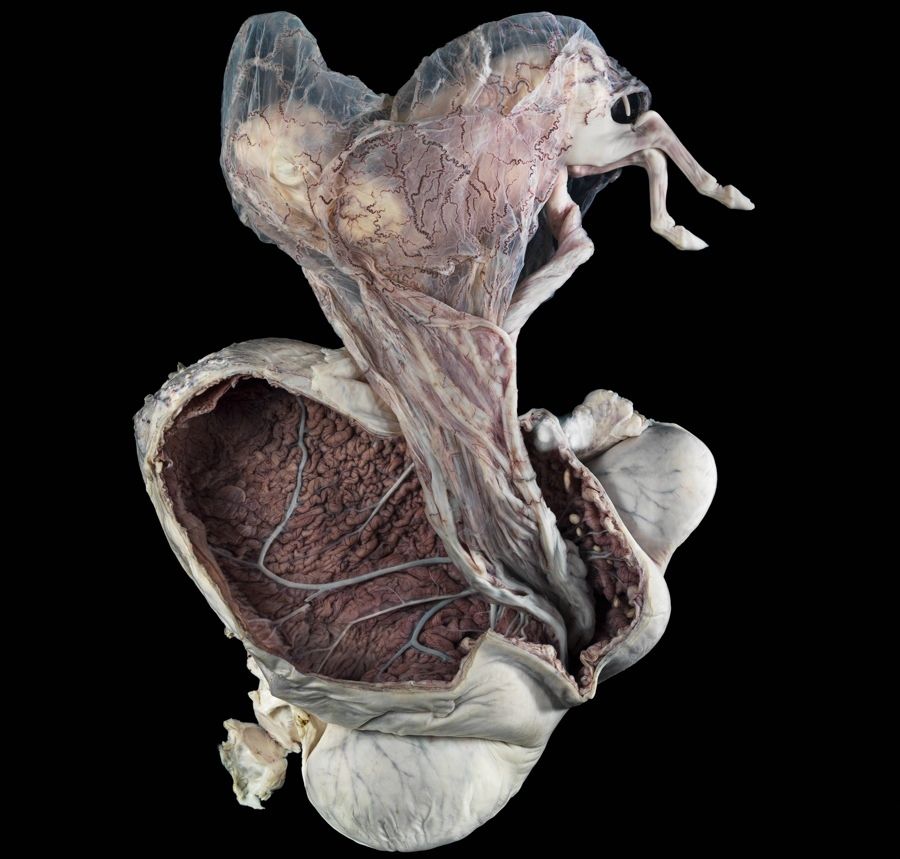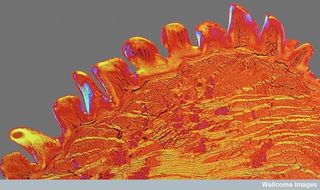'Haunting' Pony Uterus Wins Top Prize in Medical Image Contest

A potentially gruesome subject — the uterus of a pregnant pony with a fetus sticking out — shines in a beautiful photograph that snagged first place in the Wellcome Image Awards this year.
The pony uterus was one of 20 health and medical images to win top honors in the 14th annual competition sponsored by the Wellcome Trust, a research-funding agency. The photo beat other striking images, including one of a cat's tongue covered in round bumps that looked like bubbling lava (according to one Wellcome judge), an extreme close-up of the head of a boll weevil (which could play a character in a "Star Wars" flick) and an image showing 3D-printed human lungs inside a rib cage.
The judges of the 14th annual image contest were unanimous in their choice for first prize, noting the emotional response evoked by the pony uterus image. "It's fascinating, sad, macabre, almost brutal. Yet the subject is also delicate, detailed and beautiful," one of the judges, James Cutmore, picture editor of BBC Focus magazine, said in a statement. "The image shows us a large and magnificent creature reduced to this sad, fragile and half-formed creation, which I find very humbling." [See the Amazing Wellcome Award Images of 2015]
Michael Frank, of the Royal Veterinary College, captured the winning photograph, revealing the uterus of the 5-month-pregnant New Forest pony specimen preserved in formalin at the Anatomy Museum of the Royal Veterinary College in London. The pony fetus extends outside the uterus, still attached by membranes and the umbilical cord; its bent legs protrude from the membranes. "Those rear legs of a horse from an equine uterus — a compelling and haunting image," another judge, Fergus Walsh, a medical correspondent for the BBC, said in the statement.
Other compelling images included a light micrograph of a teensy parasitoid wasp (Wallaceaphytis kikiae), measuring just 0.03 inches (0.75 millimeters) long. The delicate image belies the creature's sneaky ways; the wasp lays its eggs inside other insects, and when the eggs hatch, the larvae devour the live insect from the inside out. Another honored image, a scanning electron micrograph of a greenfly eye, looks almost like a ballooning mouth of a frog.
A Dr. Seuss-like illustration by a scientific illustrator and realist painter Maurizio De Angelis of pollen grains being released from a flower in the aster family adds some whimsy to the ensemble of winning images.
And what medical image contest would be complete without at least one brain image? This year, Luis de la Torre-Ubieta, a postdoctoral fellow at UCLA, created a micrograph of a slice of a mouse brain to show the deep structures inside, including color-coded nerve cells. (An image of a living human brain snagged first prize in last year's contest.)
Sign up for the Live Science daily newsletter now
Get the world’s most fascinating discoveries delivered straight to your inbox.
"The beautiful colors and incredible level of detail in this image drew us in, inviting us to look more and more closely at it," Catherine Draycott, head of Wellcome Images, said in a statement about the mouse brain image. "The fine lines showing the nerve fibers 'shooting' across this tiny slice of brain also give it a feeling of movement and complex activity."

The judges also praised a polarized light micrograph of a cross-section of a cat's tongue, prepared on a vintage slide during the Victorian era. "This striking image looks a bit like bubbling lava, but is, in fact, the barbed surface of a cat's tongue," Walsh said. "If you've ever had a cat lick your hand and wondered why it feels like sandpaper, then this explains it. Sometimes, images that show nature in extreme close-up are both beautiful and illuminating."
The 20 honored images of 2015, chosen by a panel of nine judges, will be displayed at 11 science centers, museums and galleries, as well as in the window of the Wellcome Trust headquarters in London. The image awards were announced March 18 in London.
Follow Jeanna Bryner on Twitter and Google+. Follow us @livescience, Facebook & Google+. Original article on Live Science.
Jeanna Bryner is managing editor of Scientific American. Previously she was editor in chief of Live Science and, prior to that, an editor at Scholastic's Science World magazine. Bryner has an English degree from Salisbury University, a master's degree in biogeochemistry and environmental sciences from the University of Maryland and a graduate science journalism degree from New York University. She has worked as a biologist in Florida, where she monitored wetlands and did field surveys for endangered species, including the gorgeous Florida Scrub Jay. She also received an ocean sciences journalism fellowship from the Woods Hole Oceanographic Institution. She is a firm believer that science is for everyone and that just about everything can be viewed through the lens of science.











